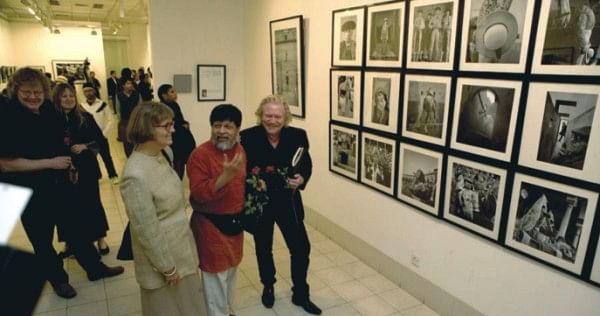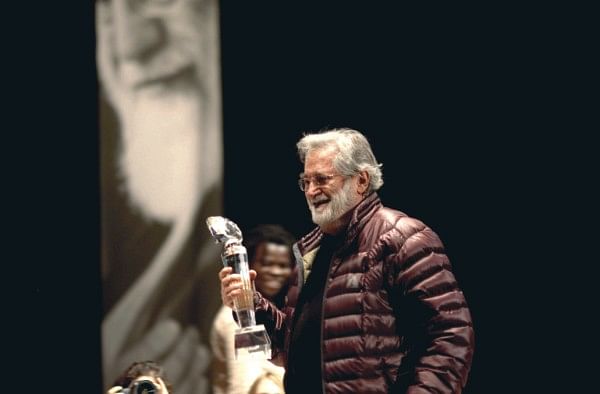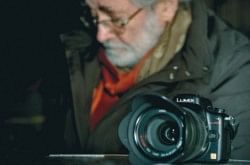Event
Painting with the Light
Chobi Mela VI
AANTAKI RAISA
“I always thought good photos were like good jokes. If you have to explain it, it just isn't that good.
– Anonymous
 |
Munem Wasif, Bangladesh.,
Photo: drik news |
Photography is an art, an art that has the power to take you on time travel; a photograph or a series of them can tell you the stories of the people you never met, can take you to the places you never went, places that might not even exist, photographs can take you back to the past, a past where YOU didn't exist. That's the sheer power of photography. With the emergence of DSLR (Digital Single Lense Reflex) cameras, photography has become a mass medium of art. Keeping in pace with its increasing popularity, Bangladesh has made its mark in this genre of art not just by producing great photographers but also by providing opportunities to the nascent photographers to be taught by, to meet with highly acclaimed, expert and professional photographers from home and abroad. Drik and Pathshala, pioneering this campaign, have been organising “Chobi Mela- International Festival of Photography” since 2000. Chobi Mela was the first international photography festival in Asia. Continuing with its legacy of success, Drik and Pathshala have organised the 6th installment of this mega event this year, which started from January 21 and will end on February 3.
Every time, Chobi Mela comes up with a new theme. Photographers, all over the world submit online, their photographs, related to the theme. Amongst the submitted photos, the chosen ones are selected for the exhibition in the festival. This time, Chobi Mela came up with the theme of “Dreams”. The director of the festival, Shahidul Alam says “Are not all photographers dreamers? We paint with light, to hold on to the ephemeral. We play with tones to arrest the fluidity of the transient. We play with form to navigate the edges of our borders. We tug and pull fleeting elements in a never-ending search to redefine what we know and discover what we don't. It is a restless search, for even in the stillness of a timeless image, the soul wanders, looking for new meaning. Old contact sheets, reworked digital files, uncoupled layers and translucent paths, vintage prints, digital composites all blend seamlessly in the curator's relentless choreography, in a festival of light and darkness.”
 |
Mario Macilau, Mozambique.
Photo: drik news |
Photographers from 30 countries are expressing their “Dreams” through 29 print exhibitions and 30 digital presentations. Nine workshops and two portfolio reviews taken by world renowned photographers like Peter Bialobrzeski from Germany, Laurence Leblanc from France, have been arranged to create a platform for the enthusiastic, upcoming photographers to get first hand experience in learning from the best in the field. Taslima Akhter, a recent graduate from the Pathshala, exhibited her photographic work on the lives and struggles of the garments workers in the same presentation session with Peter Bialobrzeski. This kind of opportunity is not just an impeccable source of inspiration; it's also a great school to learn; Peter's presentation and lecture let the beginners know the life of a photographer, the struggle s/he has to go through, the effort s/he has to put in to take that perfect shot; “Photography is neither art nor journalism; it's cultural practice,” said Peter- such philosophy on the subject opens up a whole new perspective to look at it.
Chobi Mela has not only created a platform to learn, it has also opened a new horizon to represent Bangladesh, through the aesthetic eyes of our promising photographers. A nation that is branded by floods, natural disasters and poverty, the exhibition, “High Life”, by an amateur photographer Anisul Hoque, framed the wealthy, happy lives of a Bangladeshi family. “Dhaka: My Dreams, My Reality” by Debashish Shom, displayed Dhaka life- a blend of contrasts-rich and poor,light and dark- the true story of our metrpolis.
Painted in the colour of photography- black and white- Munem Wasif's “Salt Water Tears” depicted the arduous life of the people in Sathkhira who have been victims of unplanned shrimp farming; “A novelist has to study a lot before s/he writes a novel. This series of photographs is my novel. I studied and investigated the lives and reasons behind the struggle of those people,” says Munem Wasif. Munem, a documentary photographer and a teacher at the Pathshala complains that, despite all their efforts, despite the continuous success of Chobi Mela, there is not much appeciation of photography or the photographers in Bangladesh. “We still are addressed as 'camera-man'. People still haven't grasped the idea that photography is also a form of art. Foreign photographers who have come here in the Chobi Mela are like the Picassos of photography. How many of us actually understand the opportunity we are presenting? ” Munem also pointed out at the fact that, though photography is becoming more popular day by day, our country is still to have a proper government authorised photographic institute. As a result, photography is still a subject considered to be pretty expensive. He says, “Imagine if there were no government medical colleges in Bangladesh. Imagine, all of them being private. Just think how costly it would be for the masses to afford medical college.” Despite the lapses in the governmental sector, Bangladesh is advancing rapidly in photography through private organisations. Photography festivals like Chobi Mela are the dazzling examples. “People from Australia, Malaysia are coming to Pathshala to learn photography; that's the kind of impact we have created internationally and that's the kind of standard we have set in this country,” says the festival director Shahidul Alam. “We try to bring in new flavours with each new festival. This time we have reduced the number of exhibitions but have increased the number of digital presentations and workshops, so that people can get more out of the festival,” he adds.
 |
Festival Director Shahidul Alam with renowned photographers at the exhibition.
Photo: drik news |
Chobi Mela VI presents a vast range of photographs and photography. It has the documetary of David Bournett's “44 days: Iran and the Remaking of the World”; it also shows the creative and imaginative work of David De Souza in “DREAMS”. It contains the graphic display of colours in Laurence Leblanc's “Can all dreams be found somewhere else” and the black and white world of “Salt Water Tears”. The majestic exhibition and the aesthetic play of lights take you to a different dimension- a different space and time- a different reality- like in one's dreams. Chobi Mela is enriched with many other exhibitions that promise to quench one's thirst of beauty.
Chobi Mela VI will continue till February 3 in Bangladesh Shilpakala Academy, Alliance Francaise, Goethe-Institut, Drik Gallery, Asiatic Gallery of Fine Arts, British Council and Lichutola, Faculty of Fine Arts.
Meeting the Icon
Sabhanaz Rashid Diya
One day in Spain, 1946, 11-year-old Pedro Meyer receives a present from his father. It's a camera. Intrigued, Meyer begins taking pictures. Over time, pictures become his becoming, and a legend is born.
 |
Pedro Meyer receives the Chobi Mela Lifetime Achievement Award 2011. Photo: Zabir Hasan |
Born in 1935, Pedro Meyer is lauded as one of the most innovative and accomplished photographers across the globe. At the forefront of the digital revolution, he launched the first ever CD-ROM that combined sound and image to produce an emotional photo essay (I Photograph to Remember) depicting his parents' lives, then suffering from terminal cancer. In that sense, many contemporary artists consider him the 'digital guru', a bridge between the analogue and digital era of photography. Pedro Meyer was the founder and president of Consejo Mexicano de Fotografia, and organiser of the first three Latin-American Photography Colloquiums. He has also been a teacher at various reputed institutions, and the curator, editor, founder and director of the renowned online photography platform “ZoneZero”. (Reference: www.pedromeyer.com)
In 2004, Meyer set himself to host the first world wide simultaneous retrospective. The project, titled “Heresies” comprised over 60 simultaneous exhibitions in 17 countries around the world. Over 350,000 images were at the exhibits and a book was released afterwards. In 2008, Meyer launched a newer version of the book “Heresies”. He believed the project fostered better understandings between photographs, museums, global networks and people.
This year, Pedro Meyer is a visiting artist at Chobi Mela VI as well as conducting a workshop in Pathshala. I met him under the mystifying lights of Green Café at Goethe-Institut and was immediately struck by his genuine curiosity in the world around him. Although in his mid-seventies, he spoke with energy that one would only expect from a teenager who had stumbled upon a wonderful world. We immersed into a conversation quickly, ranging from photography and art to storytelling. An obvious query was his decision to continue taking still pictures, when clearly a combination of sound and moving images could produce dramatic motion pictures or videos.
“It's because I began with still photography and felt passionate about it,” explains Meyer, smiling. “I don't think videos or motion pictures have the same depth or emotional connection with the creator – it's somewhat very passive. But with still photography, I can feel the passion, the active and emotional involvement, the personal connotations.”
 |
Pedro Meyer Photo:Zabir Hasan |
That being said, does digital photography allow the same intensity of personal attachment between the photographs and the artist? In 2010, I remember reading an editorial by Meyer at ZoneZero that eloquently summarises his take on the boom of “photographers” everywhere. His piece responds to the burning question as to whether too many people are taking pictures, and he mentions how any simple image – years from now – may prove to be an important document in history. The fact that more people are taking interest is wonderful and he believes this to be merely the beginning.
“It's amazing how technology has allowed people to become part of an extraordinary ability to tell stories through images,” added Meyer during our conversation, “I remember on the boat trip I went to in Bangladesh, I took a picture of a man in a different boat on the river. He also took out his mobile phone and took a picture of me. This is exciting! Technology has allowed people – irrespective of economic conditions – to somehow be engaged in the photographic process. This was unimaginable even a few years ago!”
So what makes a photograph the photograph? “Well, first of all, the photograph does not exist. The photograph that we like, that seems important to us are based on our cultural differences, age differences and other contextual factors,” says Meyer. “A fifteen year old boy in Mexico will like a very different photograph from a fifteen year old boy in Bangladesh because they belong to different cultures. For each of them, at that moment, that photograph is significant. As they grow older, the photograph may no longer be significant, and another photograph may seem to matter more. The photograph is anything that we like, and our likings change as we age or settle into different contexts.”
True, while the way we perceive our surroundings change over time, amidst the restless dynamism of the 21st century, if often seems we're changing too fast. The younger generations seem to experience rampant shifts in focus. What would Pedro Meyer's advice be to this lot, to the next generation of photographers? How will they keep up with the rising demands of the world around them?
“That's simple, you have to keep learning. You have to be genuinely curious and continue learning as you age. In the analogue era, there were a few techniques you'd need to master. In the digital era, not a week passes without something new, something progressive happening. It is important to adapt to these new things, to changing surroundings in order to keep up.”
As we continue exchanging perspectives, Meyer enthusiastically takes out his camera and begins explaining how fast technology is progressing. The recently marketed DSLR in his hand was touch screen with detailed components and functions that provides the photographer an insightful control over his camera. He shows me how things worked and the possibilities surrounding each aspect of this new machine that could change the photograph. The fact that I pick up something first-hand from a legend of his stature is remarkable, and this truly reflects upon his magnanimous persona. Pedro Meyer's uniqueness comes from his intrigue and excitement towards learning and experiencing something new each day. Though the world has much to learn from his unwavering wisdom, Pedro Meyer lives in the moment and grows with it, thus making him the extraordinary visionary and revolutionary figure that he is.
Copyright
(R) thedailystar.net 2010 |
| |
